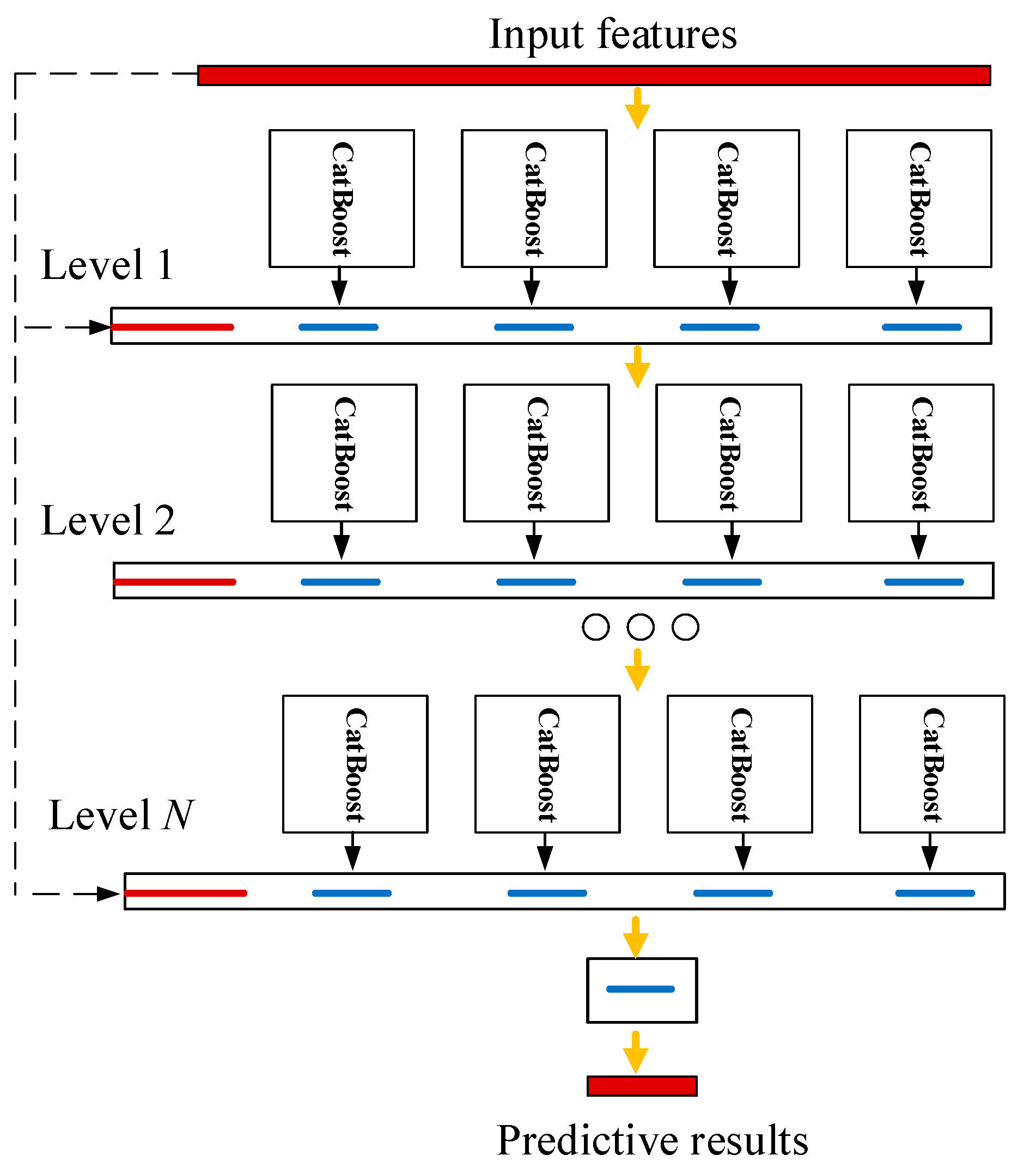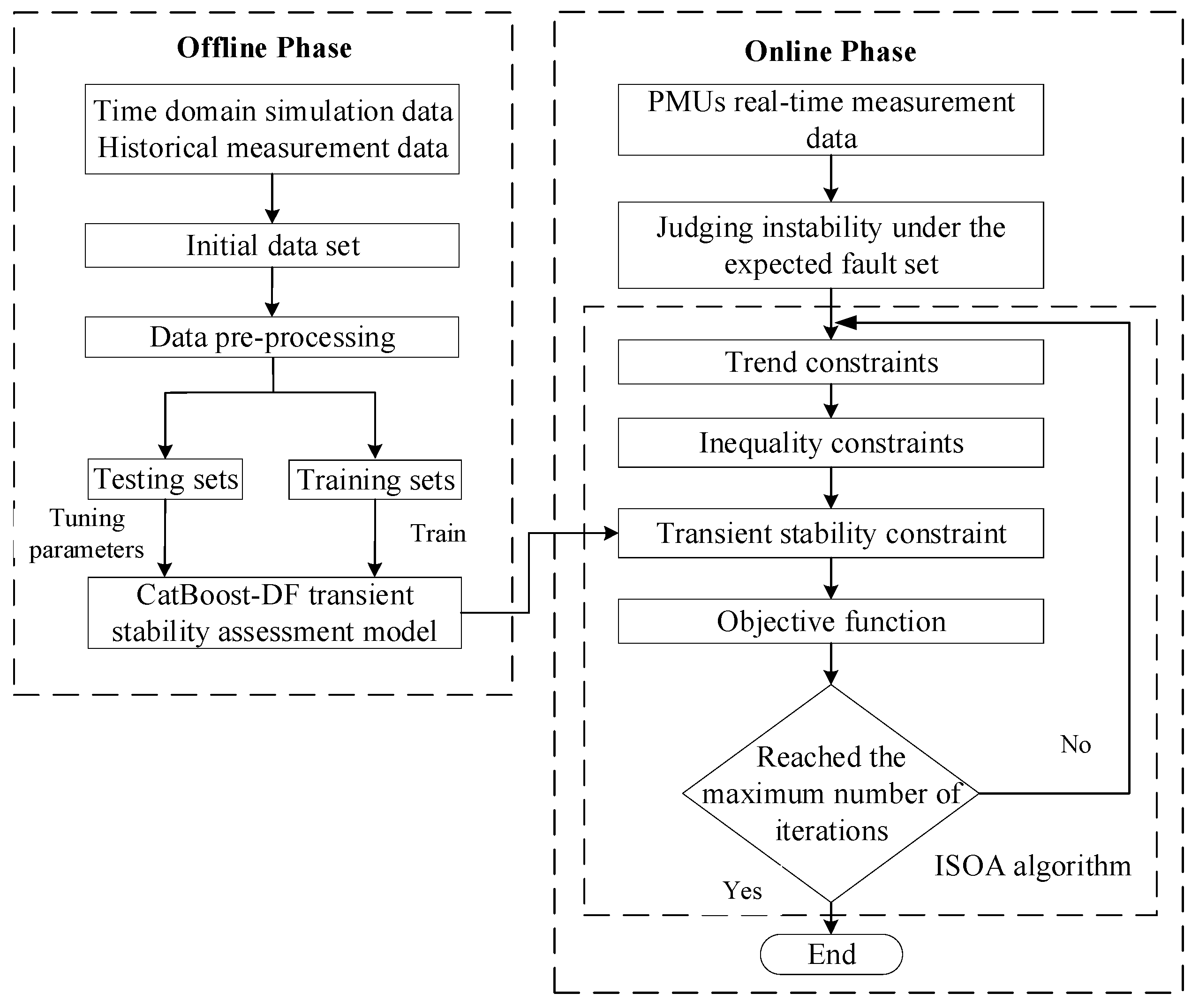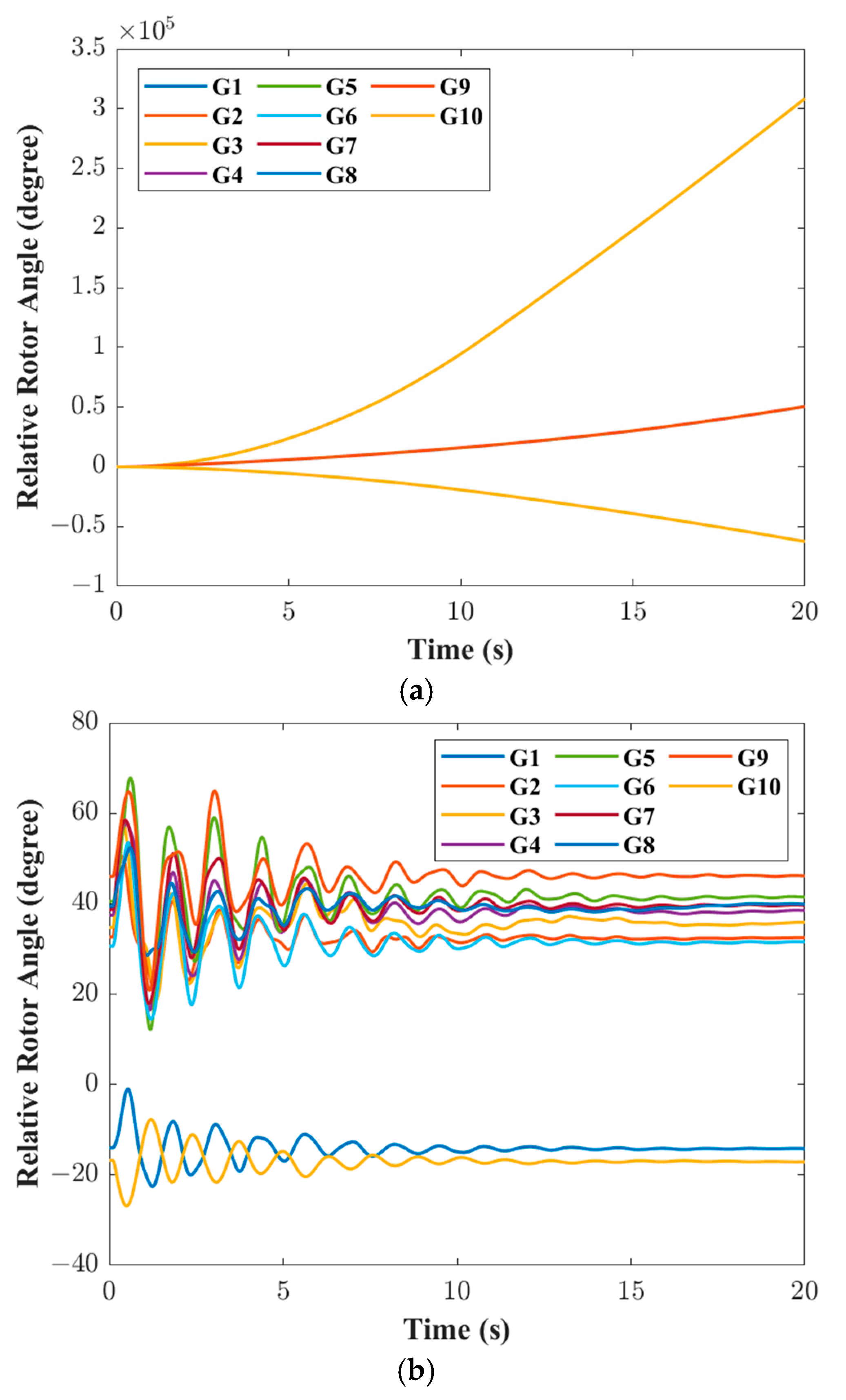1. Introduction
The safe and stable operation of power systems is a critical guarantee for industrial production and people’s livelihoods. However, with the continuous expansion of power system scale, particularly due to complex network structures and the integration of numerous generating units, the system’s dynamic characteristics have become increasingly intricate, thereby heightening the risk of transient stability loss [
1,
2,
3]. Transient stability loss is a key factor contributing to the frequent occurrence of large-scale accidents, and efficient transient stability-constrained optimal power flow (TSCOPF) methods represent a vital approach to addressing this issue [
4,
5,
6].
Traditional TSCOPF methods typically rely on complex nonlinear differential and algebraic equations to describe the dynamic behavior of power systems [
7]. Among these, classical approaches for handling transient stability constraints primarily include time-domain simulation methods [
8], direct methods [
9], and judgment methods based on post-fault system responses. Although these methods offer high computational accuracy and engineering applicability, they generally suffer from limitations of low computational efficiency and time-consuming processing. In recent years, the advancement of machine learning has brought new opportunities to power system analysis, effectively addressing the shortcomings of classical methods. Machine learning approaches possess the capability to mine data features, enabling the establishment of mapping relationships between input characteristics and outputs [
10]. Reference [
11] proposes a novel neural network-based dimensionality reduction method for data preprocessing, followed by applying an extreme learning machine (ELM) to the reconstructed data for transient stability assessment. Reference [
12] proposes a transient stability assessment method based on extreme gradient boosting (XGBoost) and factorization machines (FM). The aforementioned research aimed to develop transient stability assessment models using machine learning algorithms. However, these models featured simple structures and insufficient accuracy. Compared to traditional machine learning approaches, deep learning methods progressively extract higher-level features from raw data across multiple layers, offering advantages such as robust feature extraction capabilities and superior convergence properties [
13]. Reference [
14] proposes a squeeze-excitation (SE)-enhanced attention mechanism for graph convolutional neural networks (SE-GCN). By embedding power grid topology and explicitly accounting for network topographical effects, this model enables deep feature extraction and learning on graphs for rapid transient stability assessment. Reference [
15] proposes an active transfer learning method based on the deep belief network (DBN) model. Reference [
16] proposes a transient stability assessment model based on a spatio-temporal generalized learning system (STBLS). Reference [
17] introduces an interpretable deep learning transient stability assessment model that combines the powerful nonlinear modeling capabilities of deep neural networks with the interpretability of decision trees (DT). Although these studies have employed deep learning techniques to develop higher-precision transient stability assessment models, most of these models exist as standalone evaluation modules and have not yet been systematically integrated into the TSCOPF optimization framework to enable rapid characterization and solution of transient stability constraints.
The aforementioned research focuses on enhancing the performance of transient stability assessment through data-driven approaches. On the other hand, in the optimization solution phase, intelligent optimization algorithms have been widely applied to solve TSCOPF models due to their flexibility in handling complex nonlinear problems [
18]. Reference [
19] used the Butterfly Optimization Algorithm (BOA) to solve the Optimal Power Flow (OPF) problem in power systems; however, further improvement is needed to obtain better solutions within a reasonable time. In this paper, the Sobol sequence initialization and nonlinear control parameters are introduced to enhance population diversity and search efficiency, while the Lévy flight strategy helps the algorithm escape from local optima. As a result, the improved Seagull Optimization Algorithm (ISOA) can still converge rapidly and achieve lower generation costs and higher stability margins in a larger IEEE 39 bus system. Reference [
20] proposed a bio-inspired Multi-Objective Artificial Hummingbird Algorithm (MOAHA) to address the OPF problem in power systems, but it suffers from insufficient population diversity and premature convergence. In contrast, our ISOA employs Sobol sequence initialization and the Lévy flight strategy to effectively enhance global exploration ability, and uses the CatBoost-DF surrogate model to replace complex transient stability calculations, fundamentally reducing the number of iterations and computation time. Reference [
21] applied a Multi-Objective Particle Swarm Optimization (MOPSO) algorithm to handle conflicting objectives in the OPF problem and used fuzzy set theory to select a compromise solution. In contrast, our proposed ISOA directly searches for Pareto-optimal solutions while balancing exploration and exploitation, without requiring additional fuzzy decision mechanisms. Combined with the CatBoost-DF surrogate model, the algorithm not only optimizes static economic indicators but also enables early warning and prevention of transient instability, effectively improving system security and real-time control capability. In summary, compared with the cited metaheuristic algorithm studies, the proposed method—through the integration of a deep surrogate model and an improved swarm intelligence algorithm—demonstrates more significant advantages in terms of algorithm diversity, convergence speed, adaptability to complex constraints, and scalability for large-scale power systems.
To address the aforementioned issues, this paper proposes a TSCPOF model integrating a cascaded CatBoost model (CatBoost-DF) and an improved seagull optimization algorithm (ISOA). This method achieves coordinated system safety, stability, and economic operation by optimizing generator output under anticipated fault scenarios, effectively enhancing the computational efficiency and decision reliability of traditional TSCOPF models.
4. TSCOPF Model Based on CatBoost-DF and ISOA
4.1. Improved Seagull Optimization Algorithm
When applying the traditional seagull optimization algorithm (SOA) [
25] to solve the TSCOPF problem, issues such as insufficient exploration capability, slow convergence speed with low accuracy, and susceptibility to local optima arise [
26]. To address these challenges, this paper proposes algorithmic enhancements. First, the population is initialized using the Sobol sequence [
27] to enhance diversity. Then introduce nonlinear parameter
[
28] to enhance the algorithm’s optimization performance. Finally, a Levy flight strategy [
29] is employed to help the algorithm escape local optima.
The initial population is initialized based on the Sobol sequence. The initial positions of the seagull population are:
where
and
denote the lower and upper bounds of the value range;
is a random number in the interval [0, 1].
The mathematical formula for nonlinear parameter
is as follows:
where the initial value of the parameter
is set to 2;
represents the current iteration count;
denotes the maximum iteration count.
The Levy flight strategy is a random walk search strategy that enhances the algorithm’s ability to escape local optima. It is expressed as follows:
where
, typically set to 1.5;
.
4.2. TSCOPF Optimization Process
This paper introduces the CatBoost-DF transient stability assessment model to replace complex differential-algebraic transient stability constraints. The ISOA is employed for rapid and accurate model solution. The TSCOPF flowchart is shown in
Figure 2, comprising two main components:
First, based on time domain simulations combined with historical measurements, the six dynamic characteristics proposed in
Section 3.2 are extracted. Then, time domain simulations were conducted using the PSASP simulation software. By varying generator output levels and load sizes and randomly combining them with predefined fault sets, the transient stability index from Equation (8) was calculated to obtain the initial sample set. Outliers in the initial sample set were handled, and the preprocessed data was randomly split into training and testing sets (8:2 ratio). The CatBoost-DF model was trained and tested on these sets respectively. After model training, the transient stability constraints in the traditional TSCOPF model were replaced.
- (2)
Online Phase
By collecting real-time power system measurement data through phasor measurement units (PMUs), the system adjusts the active power output of synchronous generators based on the ISOA when instability is predicted under anticipated fault conditions. This process solves for the optimal operating point to maintain system stability.
The specific steps for solving the TSCOPF model using the ISOA are as follows:
Step 1: Initialize the population positions based on the Sobol sequence as shown in Equation (16), and set parameters such as the maximum iteration count ;
Step 2: Process power flow constraints (2) and inequality constraints (3)–(5) using Matpower, and handle transient stability constraints based on the trained CatBoost-DF model;
Step 3: Calculate the fitness value of each seagull based on the objective function. Rank each seagull according to its fitness value, eliminating the weaker ones while retaining the stronger ones. Simultaneously, introduce the Levy flight strategy as shown in Equations (18) and (19) to help the algorithm escape local optima and update the optimal value;
Step 4: Determine whether the maximum iteration count has been reached. If so, output the globally optimal solution of ISOA as the TSCOPF adjustment plan. If not, return to Step 2 to continue the iterative solution process.
6. Conclusions
In order to ensure the safety and economy of power system operation, this paper proposes a TSCOPF model based on CatBoost-DF and ISOA. Through simulation analysis and comparative experiments, the following conclusions are obtained:
(1) The constructed CatBoost-DF model, with its deep feature extraction and high-precision prediction capabilities, builds an efficient and accurate transient stability assessment tool. It is embedded as a surrogate model in the TSCOPF framework, effectively replacing the solution of complex differential algebraic equations. It provides key technical support for achieving online safety monitoring and rapid early warning of the power system.
(2) The TSCOPF model was solved by using ISOA. Compared with other swarm intelligence optimization algorithms, ISOA has better performance in convergence speed and accuracy, ensuring the economic operation of the power system.
(3) Under identical hardware and computational scenarios, when evaluating system stability using optimized TSI, online availability via total computation time, and TSCOPF model economics through generation cost, CatBoost-DF maintains values close to the time-domain simulation TSI (67.92 and 68.34, respectively) while reducing computation time from 402.91 s to 38.27 s (approximately a 90.5% decrease), outperforming both CatBoost-DF+ interior point method in speed and stability (TSI improvement of 2.21, acceleration of approximately 38.6%). It also exhibits the lowest generation cost among the three models (reducing costs by 1.5% and 11% compared to Model 1 and Model 2, respectively), thereby constituting the optimal accuracy–speed tradeoff solution for online scenarios.
(4) The TSCOPF model that integrates CatBoost-DF and ISOA achieves a good balance in terms of computational efficiency, optimization accuracy and economy compared with the traditional model. This method can quickly adjust the generator output when the risk of transient instability is detected, guiding the system from the instability edge to the stable operation domain, thereby reliably ensuring the safe and stable operation of the power system and achieving better economic benefits.











